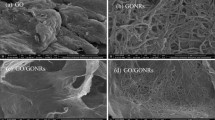Abstract
Water pollutants pose an imminent threat to human well-being and to wildlife. Aerogels and mostly graphene-based aerogels are very promising materials that could provide a breakthrough in environmental sciences in terms of pollutants adsorption. In this study, we were able to synthetize nitrogen-doped graphene-based aerogels for the adsorption of liquid toluene from water. The samples were characterized through Raman spectroscopy, thermal imaging and adsorption capacity. These super insulators were able to achieve a very high adsorption of toluene up to 42 g/g at room temperature which is very promising, especially when this capacity is conserved even after 14 cycles of adsorption. These aerogels could also be used in the separation of components from water such as oil spills and organic pollutants.




Similar content being viewed by others
References
Ji K et al (2021) A tunable amphiphilic Enteromorpha-modified graphene aerogel for oil/water separation. Sci Total Environ 763:142958. https://doi.org/10.1016/j.scitotenv.2020.142958
Zhou L, Xu Z (2020) Ultralight, highly compressible, hydrophobic and anisotropic lamellar carbon aerogels from graphene/polyvinyl alcohol/cellulose nanofiber aerogel as oil removing absorbents. J Hazard Mater 388:121804. https://doi.org/10.1016/j.jhazmat.2019.121804
Yu JG et al (2014) Aqueous adsorption and removal of organic contaminants by carbon nanotubes. Sci Total Environ 482–483(1):241–251. https://doi.org/10.1016/j.scitotenv.2014.02.129
Karpińska J, Kotowska U (2019) Removal of organic pollution in the water environment. Multidisciplinary Digital Publishing Institute, Basel
Kang W et al (2020) A novel robust adsorbent for efficient oil/water separation: magnetic carbon nanospheres/graphene composite aerogel. J Hazard Mater 392(January):122499. https://doi.org/10.1016/j.jhazmat.2020.122499
Li Y et al (2018) Bioassembly of fungal hypha/graphene oxide aerogel as high performance adsorbents for U(VI) removal. Chem Eng J 347(Vi):407–414. https://doi.org/10.1016/j.cej.2018.04.140
Wang H, Ma H (2020) Highly enhanced electromagnetic wave absorption bandwidth based on reduced graphene oxide-Fe aerogel composites. Nanotechnology. https://doi.org/10.1088/1361-6528/ab59b4
Lin Y, Liu F, Casano G, Bhavsar R, Kinloch IA, Derby B (2016) Pristine graphene aerogels by room-temperature freeze gelation. Adv Mater 28(36):7993–8000. https://doi.org/10.1002/adma.201602393
Cheng Y et al (2017) Enhanced mechanical, thermal, and electric properties of graphene aerogels via supercritical ethanol drying and high-temperature thermal reduction. Sci Rep 7(1):1439. https://doi.org/10.1038/s41598-017-01601-x
Fu K, Yao Y, Dai J, Hu L (2017) Progress in 3D printing of carbon materials for energy-related applications. Adv Mater 29(9):1–20. https://doi.org/10.1002/adma.201603486
Nassar G, Daou E, Najjar R, Bassil M, Habchi R (2021) A review on the current research on graphene-based aerogels and their applications. Carbon Trends 4:100065. https://doi.org/10.1016/j.cartre.2021.100065
Ding Y, Tian Z, Li H, Wang X (2019) Efficient removal of organic dyes using a three-dimensional graphene aerogel with excellent recycling stability. New Carbon Mater 34(4):315–324. https://doi.org/10.1016/s1872-5805(19)30020-4
Hou S et al (2020) Ultralight, highly elastic and bioinspired capillary-driven graphene aerogels for highly efficient organic pollutants absorption. Appl Surf Sci 509(November 2019):144818. https://doi.org/10.1016/j.apsusc.2019.144818
Gorgolis G, Galiotis C (2017) Graphene aerogels: a review. 2D Materials 4:032001
Wu M et al (2020) 2020 Roadmap on carbon materials for energy storage and conversion. Chem Asian J 15:995–1013
Qin W, Zhu W, Ma J, Yang Y, Tang B (2021) Carbon fibers assisted 3D N-doped graphene aerogel on excellent adsorption capacity and mechanical property. Colloids Surf A Physicochem Eng Asp 608(September 2020):125602. https://doi.org/10.1016/j.colsurfa.2020.125602
Androulidakis C et al (2021) Multi-functional 2D hybrid aerogels for gas absorption applications. Sci Rep 11:13548
Yang Z, Xing G, Hou P, Han D (2018) Amino acid-mediated N-doped graphene aerogels and its electrochemical properties. Mater Sci Eng B Solid-State Mater Adv Technol 228(August 2017):198–205. https://doi.org/10.1016/j.mseb.2017.11.028
Park S et al (2009) Graphene oxide sheets chemically cross-linked by polyallylamine. J Phys Chem C Lett 113:15801–15804
Xue B, Zhu J, Liu N, Li Y (2015) Facile functionalization of graphene oxide with ethylenediamine as a solid base catalyst for Knoevenagel condensation reaction. Catal Commun 64:105–109. https://doi.org/10.1016/j.catcom.2015.02.003
Zhou J et al (2018) Facile synthesis of three-dimensional lightweight nitrogen-doped graphene aerogel with excellent electromagnetic wave absorption properties. J Mater Sci 53(6):4067–4077. https://doi.org/10.1007/s10853-017-1838-3
Wall M (2011) The Raman spectroscopy of graphene and the determination of layer thickness. Thermo Sci 5:1–5
Li J et al (2021) Development of graphene aerogels with high strength and ultrahigh adsorption capacity for gas purification. Mater Des 208:109903
Zhai S et al (2021) N-doped magnetic carbon aerogel for the efficient adsorption of Congo red. J Taiwan Inst Chem Eng 120:161–168
Yu L et al (2018) Adsorption of VOCs on reduced graphene oxide. J Environ Sci 67:171–178
Author information
Authors and Affiliations
Corresponding author
Ethics declarations
Conflict of interest
The authors declare that they have no conflict of interest.
Additional information
Publisher's Note
Springer Nature remains neutral with regard to jurisdictional claims in published maps and institutional affiliations.
Rights and permissions
About this article
Cite this article
Nassar, G., Youssef, S. & Habchi, R. Nitrogen-doped graphene aerogels for highly efficient toluene removal from water. Graphene and 2D mater 7, 51–57 (2022). https://doi.org/10.1007/s41127-022-00049-9
Received:
Revised:
Accepted:
Published:
Issue Date:
DOI: https://doi.org/10.1007/s41127-022-00049-9




